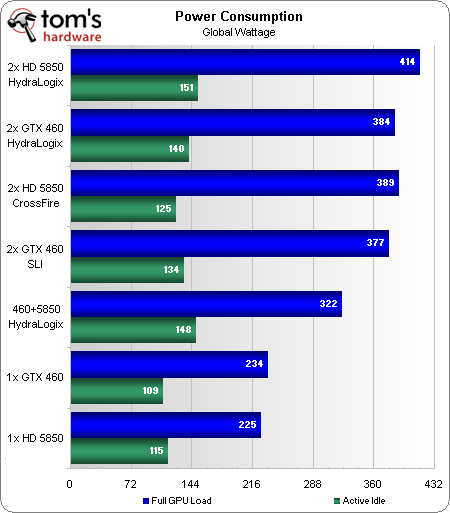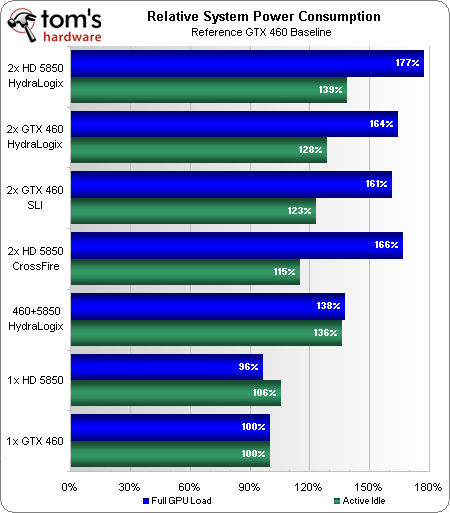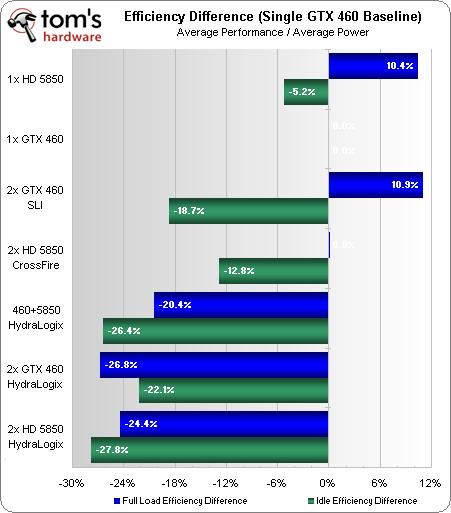HydraLogix Vs. SLI And CrossFire: MSI's P55A Fuzion Tested
LucidLogix forges ahead with its promise of multi-GPU compatibility across multiple graphics architectures and platforms. Today we see how its latest drivers stand up to the performance standards of CrossFire and SLI on a much more cost-sensitive board.
Power And Efficiency
HydraLogix appears to use more power than CrossFire or SLI, which makes sense since the Hydra 200 is rated at 6 W. Other minor differences between our Lucid and non-Lucid motherboards likely account for remaining power differences.
The power numbers for today’s charts probably look a bit different than those of other articles, because we used a different program to test it. HydraLogix does not support FurMark, but does support 3DMark. So, the latter benchmark’s Perlin Noise test was used to push every GPU to a very high load.
Putting power consumption on a percentage scale allows us to calculate efficiency more easily.
We arrived at our efficiency numbers by dividing average performance by average power used and subtracting “1” from the result. That subtraction takes us from a 100% baseline to a 0% baseline so that only the differences are seen in the charts.
We see that a Radeon HD 5850 is around 10% more efficient at full load than a GeForce GTX 460, but that two GTX 460s are more efficient than two HD 5850s. Skewing the results are things like CPU power and SLI or CrossFire scaling. Because Lucid’s solution only benefited some games, HydraLogix configurations always fall to the bottom.
Get Tom's Hardware's best news and in-depth reviews, straight to your inbox.
-
duk3 Looks good on the 1st 2 games and synthetics.Reply
I hope Lucid gets all the issues worked out. -
anacandor So basically it's just a universal CF/SLI connecter built into the motherboard? Seems odd that it's taken this long to be developed, but great nonetheless :)Reply -
Darkerson Looks like it has some promise, if they can further work the kinks out. Something to keep an eye on in the future.Reply -
punnar I can see it as a standard in the future. I think I will buy a board with Hydralogix on my next build.Reply -
Yargnit It would have been nice to see how well this works with two differing AMD/ATI cards and two Nvidia cards. For instance someone has a GTX260 and wants to add a GTX460, or someone with a AMD5850 who wants to pick up a new 6870 (damn numbering change) to go with it.Reply
Also comparing performance pairing two cards from the same generation (say GTX 460 + GTX 470) vs differing generations. (GTX 260 + GTX460)
Lastly what affect would pairing a two cards with varying amounts of memory have? (two regular versions of a card vs 1 reg + 1 dbl memory vs 2 dbl memory) Since it isn't clear from what I've read if both cards would be limited to lowest memory level or not.
Interesting tech for sure -
sudeshc this should become a standard, allowing us to enjoy features from both manufacturers. I would also be prepared to pay few extra bucks for this as well.Reply
-
Maziar Overall,Lucid is a great idea of mixing different cards but it still needs quite a lot of work with drivers.Reply -
Yargnit Ah, thank you. It was posted before I was frequently following the site, I'll give it a look.Reply



